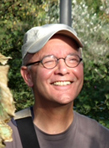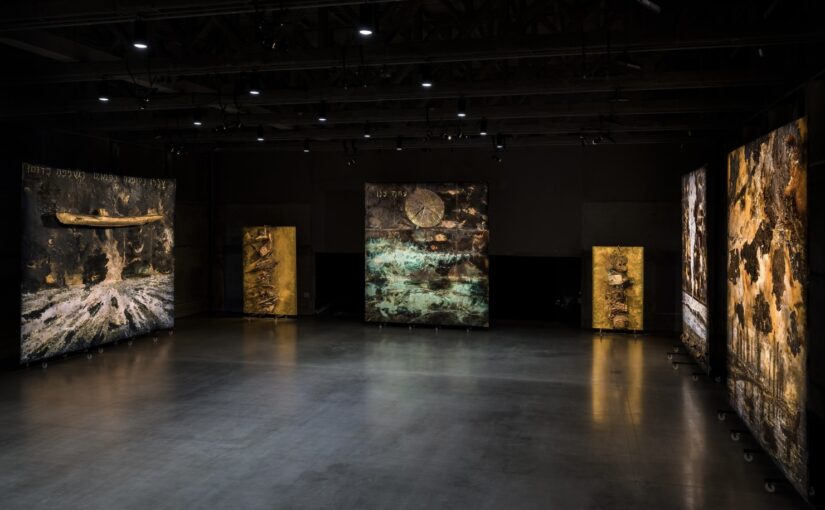INTERVIEW, March 21, 2023
Melissa Bianca Amore*) (=MBA), Anselm Kiefer (=AK)
EXODUS at Gagosian at Marciano Art Foundation in Los Angeles
NB Klik rechtsboven op afbeeldingen om te vergroten.
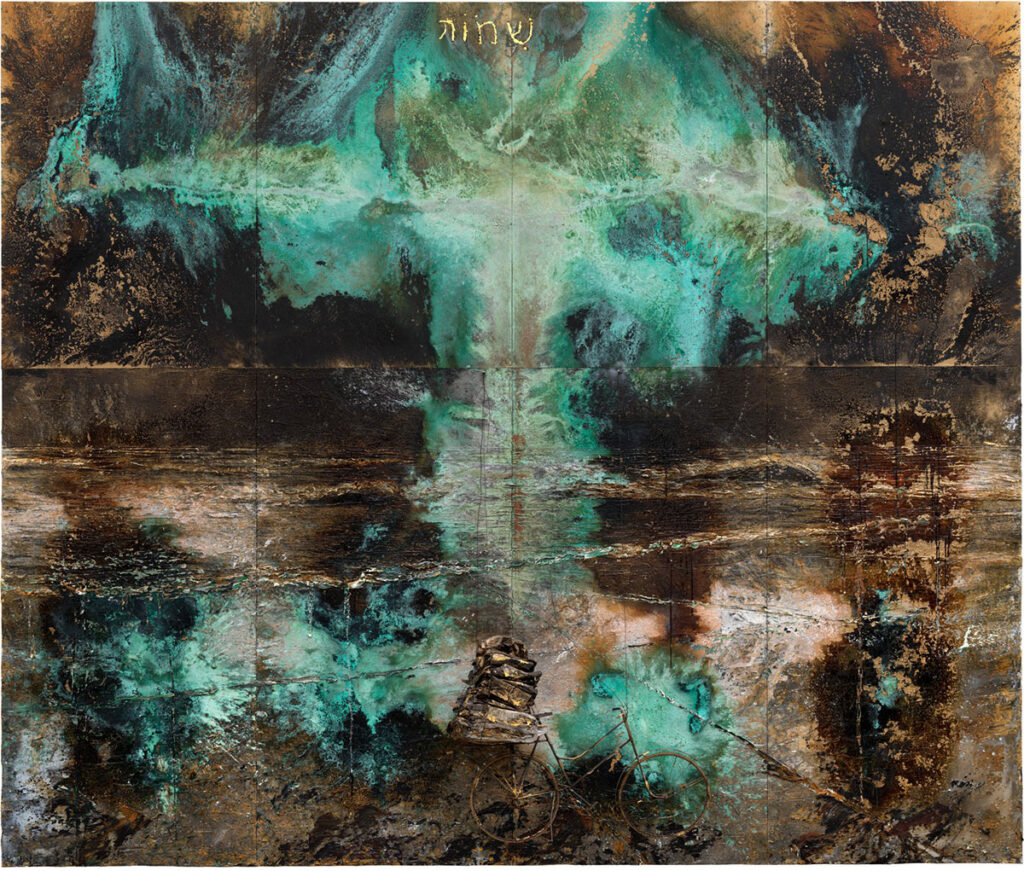
Emulsion, oil, acrylic, shellac, gold leaf, sediment of electrolysis, metal, rope, and paper on canvas, 259 13/16 x 299 3/16 inches. © Anselm Kiefer. Courtesy the artist and Gagosian.
In Exodus at Gagosian at Marciano Art Foundation in Los Angeles, Kiefer rewrites memory by “cross-mapping” collective histories layered with literary strata from Paul Celan to E. T. A. Hoffmann. While Exodus recalls the story of the Israelites departure from Egypt in the Old Testament, works in the exhibition are bloodstained from human genocide. Kiefer’s ability to obscure such gravity with a promise of divine or cosmological intervention pronounces a powerful bifurcation between eschatology and genesis, and between the experience of void and weight. As he states in his lectures delivered at the Collège de France, “an empty space always implies the opposite.”
How do we remember, and what do we remember? How does the mind render our historical memory into new conceptions of reality? With an acute profundity and a physical scale overwhelmingly large, Anselm Kiefer’s labyrinthine paintings of remembrance bear a psychological weight while revealing a human ontological wound so resonant that even the most conversant spectator becomes disembodied by their confounding complexity. Defying conventional categorization, his paintings signal a new form of architecture or spatial structure, almost like an architecture of memory.
Melissa Bianca Amore
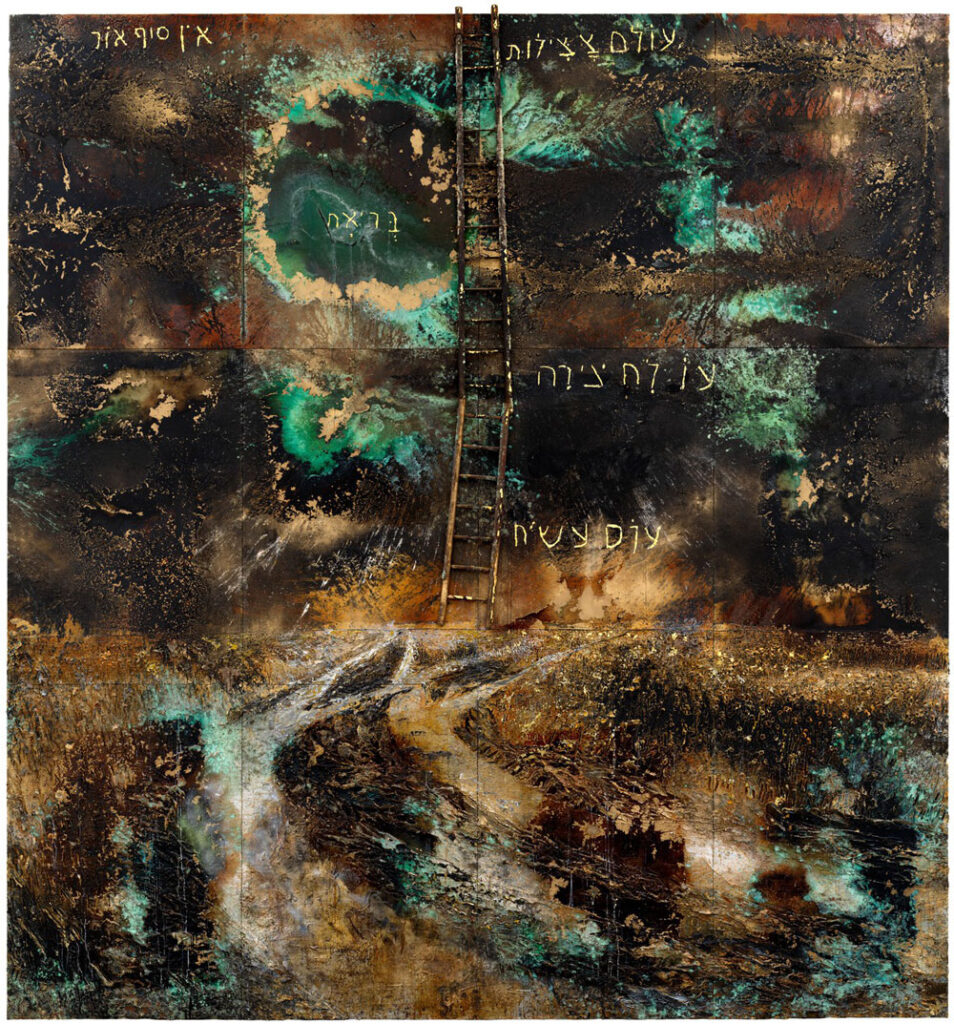
Emulsion, oil, acrylic, shellac, gold leaf, sediment of electrolysis, metal, and wood on canvas, 8.4 × 7.6 m
—Melissa Bianca Amore:
In Exodus, two divergent works entitled En Sof (2020–22) and Enterdung Sonderaktion ’Exhuming Special Action 1005’) (2021–22) frame the use of dialectical combinations prevalent throughout your practice between divinity and human annihilation, and between void and weight. The symbol of Jacob’s Ladder ascending to a spiritual passage in En Sof (Hebrew for “infinity”) references transitional states of cyclicality, cosmology, and motion, while the bone crusher in Enterdung Sonderaktion (Exhuming Special Action 1005) recounts the bloodstained Holocaust and the Nazi special operation formed to obliterate evidence of the genocide. Are these opposing temporal states or psychological borders suggestive of your belief that time or consciousness is coexisting?
—Anselm Kiefer:
I thought I knew everything about the Holocaust, but then I read Andrej Angrick’s two-volume book, ’Aktion 1005’ (2018). It describes how the Nazis tried to exhume the bodies and crush bones into dust to hide traces of the genocide; this was the climax of the atrocity. Parents witnessed their babies being exhumed. It was the most horrible thing. There is no forgiveness. The Germans covered up a lot of evidence.
Exodus is not only about the Holocaust; it’s also about borders and the idea that borders are illusions. They are mobile, not a reality. We try to have borders even in the sky, as we organize it with constellations. So it’s not only about the exodus of the Jews escaping from Egypt but the general idea of redemption and the migration of people. It’s also a personal exodus of getting out of yourself.
I exist in all time. We have our human time, between seventy and one hundred years, and we have geologic and cosmic time. I’m in all three; I cannot separate one from the other. I’m part of the rocks and part of this movement; I’m inside the stones and part of the erosion.
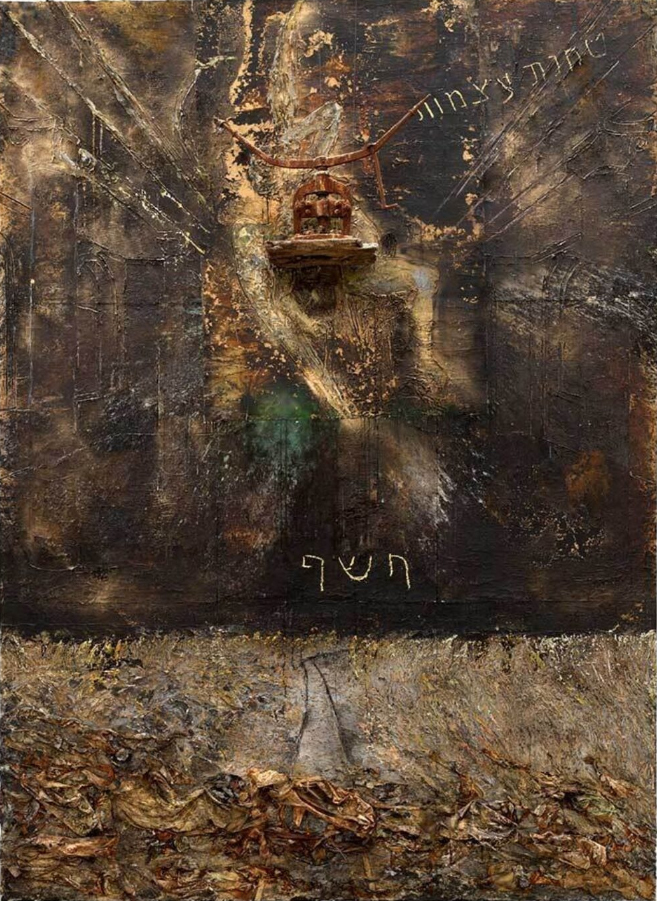
Emulsion, oil, acrylic, shellac, gold leaf, descent of electrolysis, metal, fabric, wood, clay, and charcoal on canvas. 840 x 570 cm
MBA:
In an interview with Klaus Dermutz in which you discuss how you reveal the spirit hidden in stones, you say: “I make matter secretive again by exposing it.” This is an interesting parallel to the belief that humans are embedded in rocks. It’s also synonymous with the term “Hylozoism,” a philosophical theory that all matter is in some sense alive.
AK:
Yes, rocks are conscious. We are not the only ones with consciousness. I’m not a Platonist. Plato proposed that ideas are imprinted in the objects, and I believe that objects and materials already have a spirit inside of themselves, and the artist has to discover it, uncover it. That’s our work. Some materials have more of a spirit for me—for example, lead or straw.
MBA:
You employ another kind of spiritualization and alchemical extraction to produce the materials you use. For example, in the two works discussed, an opal green emulsion creates such an intense force that it alludes to a cosmological or divine intervention.
AK:
Yes, it’s an alchemical process and extraction of the spiritual. You can’t find that color in paint, so there is no other way to create it besides collecting the sediments from electrolysis. It’s the positive and negative ions reacting with copper and salt or one metal on the other. The sediments gather at the bottom of a bath, and it’s a kind of spiritualization.
MBA:
Enterdung Sonderaktion (‘Exhuming Special Action 1005’) reveals a double meaning in the possibility of history being obliterated by concealing truth. It challenges the authenticity of knowledge distribution while disclosing how authorship is often controlled. The Hebrew inscription for “uncover” here is also allusive. It aligns with the central question in your practice of personal and historical memory.
AK:
In Jewish belief, the letters of the Hebrew alphabet are holy. Regardless of how one arranges them, they have meaning, even when they are placed together randomly. There is also the notion of the lost letter, which, if found, could change the world and redeem it.
You study history through various sources, though history is impregnated in the earth. History doesn’t exist as a fait accompli; it’s not fact. Each culture creates its own history. For example, after the Russian Revolution, the Soviets eliminated people from history. Leon Trotsky was removed from photographs because for them he shouldn’t exist anymore. History is not stable. For me, as an artist, I create my own history.
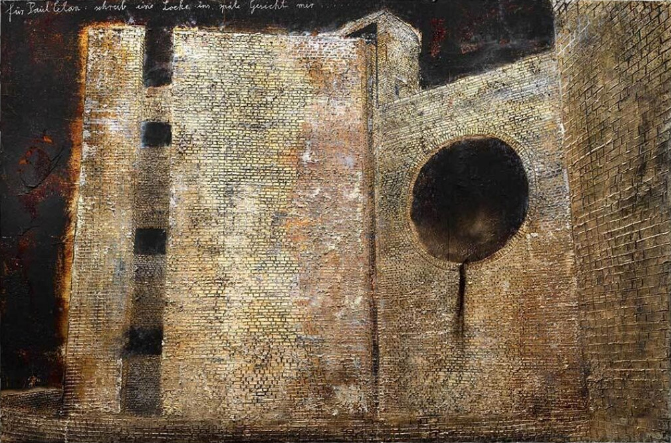
‘Schreib eine Locke ins späte Gesicht mir’
MBA:
Yes, and you reorient the linearity of historical memory. You also redefine the term mimesis by implementing a system of “cross-mapping” collective histories with literary strata. For example, in your work Für Paul Celan (For Paul Celan) (2021), an intertextual relationship is formed between architecture and language with Louis Kahn’s Indian Institute of Management building in Ahmedabad and Paul Celan’s poetic verse “schreib eine Locke ins späte Gesicht mir” (“write a curl into my late face”). Your idea “that the truth lies in the difference” is significant here.
AK:
Mimesis is an old term, and for me it doesn’t exist. History is agile; it’s a sculptural material. Cross- mapping is when you have different information like synapses that you connect. When you combine different things together like an idea with another concept, you cross-map. One sentence or fact is never alone; it’s always in contact with a lot of other synapses. My brain is always making associations to something else; I cannot stop this, for example, the connection between Kahn’s building and Celan’s poem.
Celan’s poetry is about transition, the movement. To “write a curl into my late face” is about the passing of time, growing into an older face; it’s moving toward the end. It’s like fragmenting a face and taking a curl and placing it in the face of another time. It’s about sliding time; you don’t have something to hold on to. It’s a wonderful phrase in German.
And with this sentence I dissolve the solid Kahn construction. We think it’s solid and stable, compact and unmovable, but it’s not. I like that about Kahn’s buildings; they appear to be so solid, yet they are pierced. And Celan’s curl fragments the building. By placing this sentence over it, the sentence moves the bricks in the building, and I begin to see the ruins. They would be nice ruins because they’re all bricks.
When I was a boy, I played with bricks from the debris of the bombs. I constructed things with these bricks. So I don’t look at them as being damaged but rather as the starting point. It’s not the end; it’s the beginning. The bricks still hold the building’s memory, though it’s a transition.
MBA:
Your examinations into transitional states, cyclicality, tunnels, and bridges are cited throughout your practice, including your monumental estate in Barjac, France. What is the connection between a transitional psychological state and the physical passage?
AK:
The tunnels in Barjac illustrate that the concept is the only thing that remains. It’s like the book The Underground Railroad by Colson Whitehead, which is part real and part imaginary. First, you think it’s a real tunnel; then it becomes a spiritual tunnel. It takes you from one place to the other.
MBA:
Is this concept similar to your discussion of Claude Monet’s haystacks as about the space in- between?
AK:
Yes, Monet’s haystacks are also about time and intervals. The seeing happens between the haystacks, as Monet paints different times throughout the day and combines these moments. It’s not one definitive painting; rather, it’s about the transition. The main thing happens between the painting as it moves from one state to the other.
MBA:
In your lectures at the Collège de France, you discuss another type of passage in relation to how the brain constructs images. It’s a provocative insight. You say: “Light—in other words electromagnetic waves—strikes the retina, producing different images in us. . . . From the retina, the waves travel to the brain, and, owing to the fact that their passage from the retina to the brain remains unexplained, there is an enduring mystery about the way images are produced.”
AK:
Yes, that’s fantastic. The nerve goes from the eye to the brain, and then the brain constructs the image. I think the way it constructs the image is the most mysterious thing, because we don’t know where the image is coming from. There are different theories, and some philosophers say it’s all imagination, that we imagine it all, that it’s not real.
MBA:
This analogy of a mysterious passage creating an image brings me to the use of photography in your practice. You often layer a photograph as a material similar to how you layer language or architecture.
AK:
Yes, and the difference between photography and a painting is that a photograph takes a moment, nothing else. And a painting spans one year to three hundred years, because what you see with your eyes is something complete; it has a past and a future.
When I use photography in my books, for example, I change the character of the photograph. It’s not of the moment; you have to look through hundreds of pages as a continuum, and this also plays with time.
MBA:
You have said that the poem is the only real thing that exists for you. This concept reaches far beyond the corporeal world, yet segments us right back into it. It’s a nice tension. In your lectures at the Collège de France you say: “Only poems are real, because in the end poetry for me is the only possible reality, everything else is pure illusion.” This statement also reinforces your mistrust in science to reveal the truth in reality.
AK:
Yes, theories in science, and in particular string theory which tries to explain the world, are contradictory. They are not perfect, because in twenty years another theory is developed, which changes the way we understand reality. We don’t know why we are here and where we came from.
When I look at the machine, I think it’s an illusion. But the poem you cannot change; it’s impossible. When I read a poem, it’s so precise; it’s so real. The poem for me is like a buoy in the sea where I can hold myself up.
*) Melissa Bianca Amore, philosopher, critic, and curator based in Paris and New York City, BOMB Magazine,
| ANSELM KIEFER-ZEVENLUIK OP SHAKINGLIFE |
| 1. Sag mir wo die Blumen sind |
| 2. De strooien offers van Kiefer |
| 3. De zinsbegoocheling van Kiefer |
| Bijlage: Anselm Kiefer, ‘Waldsteig’ |
| 4. Unter einem Zuckerhimmel |
| 5. Het bos en de rivier |
| 6. The Painting of History |
| 7. The Language of Material |
| Bijlage: Anselm Kiefer: The Terror of History, the Temptation of Myth |
